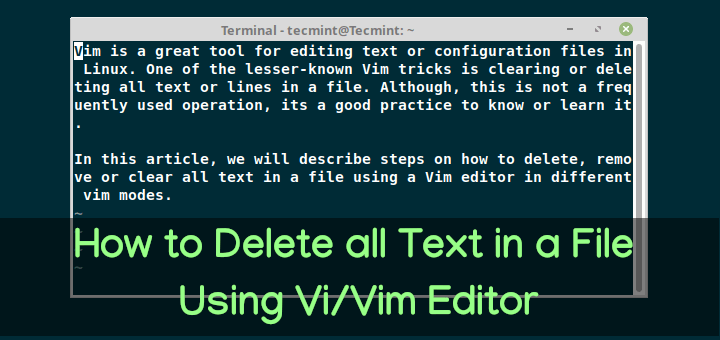
The vi editor is exactly the same for any version of Unix and Linux systems. Here is a brief introduction to its usage and a small number of instructions. Its power is not inferior to any latest text editor. Vi is included in the most popular Linux distros like Ubuntu, Linux Mint or Debian.The vi editor is a standard editor for all Unix and Linux systems. The name vi is derived from the shortest unambiguous abbreviation for the ex command visual, which switches the ex line editor to visual mode. Vi is a screen-oriented text editor originally created for the Unix operating system.
':r filename') that will read the contents of filename into the document you are editing, while r is simply a vi command that replaces a single character.Basically, vi can be divided into three states: command mode, insert mode, and last line mode. So, for example, :r is an ex command that expects an argument (e.g. It was developed starting around 1976 by Bill Joy at UCB, who was tired of the ed editor.The vi editor is based on a another editor called ex, and it retains the ex commands through the colon prompt. After learning it, you will be able to travel to the world of Linux.The vi editor is one of the most common text editors on Unix.
Vi Editor How To Search In
Command mode: Control the screen cursor movement, delete characters, words or lines, move and copy a certain section and enter Insert mode, or go to last line mode.Using the VI Editor ENTERING VI is done via a command of the form vi filename CASE: note that VI commands are case-sensitive - for example, the command R. This tutorial shows you how to search in Vim/Vi with practical examples. Searching in Vim/Vi for words or patterns is a common task that allows you to navigate through large files easily. They are both open-source (free) and available on most Linux and macOS distributions. Vim and its older counterpart Vi are widely used text editors.

Each time you press it, the character “front” of the cursor position is deleted.“#x”: For example, “20X” means delete the “front” 20 characters at the cursor position.“dd”: Delete the line where the cursor is located.“#dd”: delete line # starting with the cursor“yw”: Copy the characters from the cursor position to the end of the word to the buffer.“yy”: Copy the line under the cursor to the buffer.“#yy”: For example, “6yy” means to copy 6 lines of text “count down” from the line where the cursor is located.“p”: Paste the characters in the buffer to the cursor position. Switch from insert mode to command-line modeVi can directly use the cursor on the keyboard to move up, down, left and right, but regular vi uses lowercase English letters “h”, “j”, “k”, “l” to control the cursor left, down, up, and right, grid.Press “ctrl” + “b”: the screen moves one page back.Press “ctrl” + “f”: the screen moves forward one page.Press “ctrl” + “u”: the screen moves half a page to the “back”.Press “ctrl” + “d”: the screen moves half a page “forward”.Press the number “0”: move to the beginning of the article.Press “G”: Move to the end of the article.Press “$”: Move to the “end of the line” where the cursor is located.Press “^”: move to “beginning of line” where the cursor isPress “w”: the cursor jumps to the beginning of the next wordPress “e”: the cursor jumps to the end of the next wordPress “b”: the cursor returns to the beginning of the previous wordPress “#l”: the cursor moves to the #th position of the line, such as 5l, 56l.“x”: Each time you press, the “behind” character at the cursor position is deleted.“#x”: For example, “6x” means to delete 6 characters “behind” at the cursor position.“x”: X in upper case. Insert mode Press “i” to switch to insert mode “insert mode”, press “i” to enter insert mode and start to input files from the current cursor position After entering the insert mode by pressing “a”, the text is entered from the position next to the current cursor position After pressing “o” to enter the insert mode, a new line is inserted, and the text is entered from the beginning of the line.2). As a result, the computer keeps beeping and suffocates himself, so after entering vi, do not disturb it first, switch to “insert mode”!B) Switch to Insert mode to edit the fileIn the “command mode”, click the letter “i” to enter “insert mode”, at which point you can start typing.You are currently in “insert mode”, you can only enter text all the time if you find that you have made a typo! If you want to use the cursor keys to move back and delete the word, you must first press the “ESC” key to go to “command mode” and then delete the text.In “command mode”, click the “:” colon key to enter “Last line mode”, for example::w filename (enter “w filename” to save the article with the specified filename):q! (enter q ! force exit vi without saving) Command mode function keys1).
Enter a number after the colon and press the Enter key to jump to that line. 4.Introduction to commands in Last line modeBefore using “last line mode”, please remember to press “ESC” key to make sure you are in “command mode”, then press “:” colon to enter “last line mode”.“set nu”: After entering “set nu”, the line number is listed before each line in the file.“#”: “#” Signifies a number. Press “u” multiple times to perform multiple replies.“cw”: change the word at the cursor to the end“c#w”: For example, “c3w” means change 3 words“ctrl” + “g” lists the line number of the line where the cursor is located.“#g”: For example, “15G” means to move the cursor to the beginning of the 15th line of the article.

W filename stores the file being edited as a filename.


 0 kommentar(er)
0 kommentar(er)
